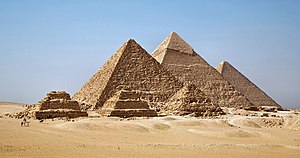
Back Haus der Ewigkeit (Altes Ägypten) German Casa de Eternidad (Antiguo Egipto) Spanish Maison d'éternité French
| House of Eternity in Hieroglyphs | |||||
|---|---|---|---|---|---|
| Old Kingdom of Egypt |
Per-djet Pr-ḏ.t House of the Eternal Time / | ||||
| Ancient Greek | Aidioi oikoi Houses of Eternity | ||||
 | |||||
In ancient Egypt, the term house of eternity refers to a tomb that consists of a pit, a tomb shaft, or from mudbricks, which were later carved into rocks; or built on open land. Burial sites made of stone were a "sign of immortality", due to the long durability of stone. This was an ideal construction method that could be afforded by only a very few ancient Egyptians, due to its high cost. In ancient Egyptian mythology, the construction of a monument during one's own lifetime represented the most intensive representation with the connection of life; and the concept of living in the afterlife. [citation needed]
The house of eternity was "a place to meet oneself" for the tomb owner and contained decorations portraying the owner's likeness, and the stages of their lives. The owner immortalised themselves with their portrait on the walls of the tomb, along with the inscriptions, to resurrect them in "a new life in later times". The tomb owner depicted their "completed life" in anticipation of their death, which according to their beliefs, was to be removed from this form; in the portrayal of oblivion and mortality. [citation needed]
The tomb owner hoped that through immaculate moral conduct, they would meet their Ka in the afterlife. The house of eternity was the place that enabled the tomb owner to endure unwavering, in the 'eternal life' (djet). With that said, the ancient Egyptians began to spend the most important annual celebrations in the house of eternity. [citation needed]